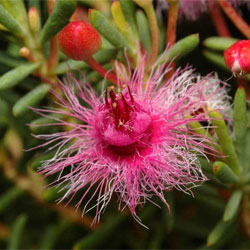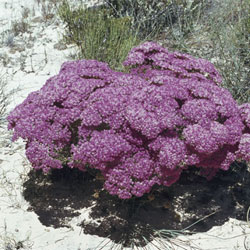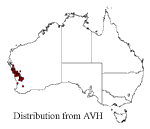Verticordia monadelpha
 |
 |
Pink Morrison, Pink or White Woolly Featherflower
In the family Myrtaceae, consisting of around 100 species, the genus Verticordia (common name featherflowers) only occurs in Australia. Apart from one species on the Eyre Peninsula in South Australia and three in the tropical north of Northern Territory and Western Australia, the remainder are endemic to the south-west shrubland and sand heaths of Western Australia.
 The popularity of some species, including Verticordia monadelpha, for floral arrangements has resulted in over picking from the wild , and research for farming of selected forms is being undertaken.
The popularity of some species, including Verticordia monadelpha, for floral arrangements has resulted in over picking from the wild , and research for farming of selected forms is being undertaken.
The petals of Verticordia monadelpha are fringed with long cilia, giving the flower a woolly appearance, thus is commonly known as the Woolly Featherflower. The base of the stamen filaments forms a cup in the centre of the flower. The flowers are 10-15 mm wide and come in various colours, ranging from white to dark pink.
The glabrous, fleshy leaves are 1-3 cm long and are triquestrous (with a triangular cross-section), and are arranged in opposite pairs.
The distribution of this species extends from just east of Perth, to just north of Geraldton in Western Australia.
Propagation by cuttings is the preferred method, due to a low success rate in seed germination. Cuttings grafted onto Darwinia citriodora have enabled this species to be grown with greater success on the more humid east coast. However, few nurseries pursue this option, as it is not as economically viable as standard cuttings.
It is a reasonably hardy species, but can be difficult to maintain and tends to be shorter-lived in the eastern states than on the west coast. They are however susceptible to soil iron deficiency and collar rot in cooler seasons.
V. monadelpha is tolerant of frosts (to –7°C) and, given a well-drained, acid sandy loam soil in a sunny position and using pebble or leaf mulch, rather than a wood mulch, success rates are much improved.
A dense rounded shrub to 1 m high by 1 m wide, this plant produces masses of flowers in late spring to early summer and sometimes, if irrigated or with excessive summer rains, may flower twice in a year. These features make it an excellent plant for small rockery gardens as well as larger landscaping projects. They are also ideally suited for tub and patio gardens. Tip pruning, when young and after flowering will keep them dense and rounded.
Text by
Sally Jacka (2005 Student Botanical Intern)
Derivation of the name: Verticordia monadelphaVerticordia - from the Latin words ‘vertere', to turn and ‘cordatus', of good heart. It is a reference to the ancient Roman goddess Venus, who was regarded as the goddess of beauty and love and considered to have had the power to bewitch, enslave and turn the hearts of her suitors. Her sacred flower was the Myrtus, or Myrtle, which belongs to the family Myrtaceae, as does Verticordia. monadelpha - from the Greek word monadelphus , meaning ‘with filament or stamens united in one'. |
References
George, E.A. (2002) Verticordia. The turner of hearts. University of Western Australia Press.
Holliday, I. And Watton, G. (1978) A Field Guide to Australian Native Shrubs. Rigby Books.
Stearn, W.T. (1973) Botanical Latin. David and Charles Newton Abbot.
Wrigley, J.W. and Fagg, M. (2003) Australian Native Plants. Propagation, cultivation and use in landscaping. Reed New Holland.
![An Australian Government Initiative [logo]](/images/austgovt_brown_90px.gif)

